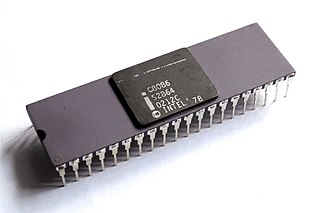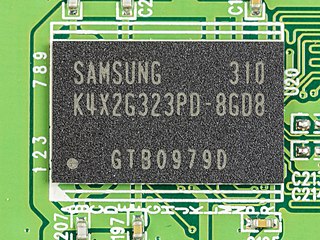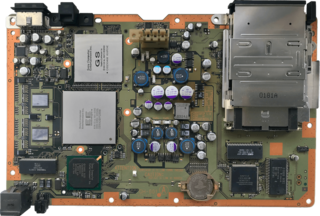
The 8086 is a 16-bit microprocessor chip designed by Intel between early 1976 and June 8, 1978, when it was released. The Intel 8088, released July 1, 1979, is a slightly modified chip with an external 8-bit data bus, and is notable as the processor used in the original IBM PC design.
In processor design, microcode serves as an intermediary layer situated between the central processing unit (CPU) hardware and the programmer-visible instruction set architecture of a computer. It consists of a set of hardware-level instructions that implement higher-level machine code instructions or control internal finite-state machine sequencing in many digital processing components. While microcode is utilized in general-purpose CPUs in contemporary desktops, it also functions as a fallback path for scenarios that the faster hardwired control unit is unable to manage.

Synchronous dynamic random-access memory is any DRAM where the operation of its external pin interface is coordinated by an externally supplied clock signal.

The Intel 8085 ("eighty-eighty-five") is an 8-bit microprocessor produced by Intel and introduced in March 1976. It is software-binary compatible with the more-famous Intel 8080 with only two minor instructions added to support its added interrupt and serial input/output features. However, it requires less support circuitry, allowing simpler and less expensive microcomputer systems to be built. The "5" in the part number highlighted the fact that the 8085 uses a single +5-volt (V) power supply by using depletion-mode transistors, rather than requiring the +5 V, −5 V and +12 V supplies needed by the 8080. This capability matched that of the competing Z80, a popular 8080-derived CPU introduced the year before. These processors could be used in computers running the CP/M operating system.

Sound Blaster is a family of sound cards and audio peripherals designed by Singaporean technology company Creative Technology. The first Sound Blaster card was introduced in 1989, and since then, the Sound Blaster brand has become synonymous with high-quality computer audio.

The Gravis UltraSound or GUS is a sound card for the IBM PC compatible system platform, made by Canada-based Advanced Gravis Computer Technology Ltd. It was very popular in the demoscene during the 1990s.

The Blackfin is a family of 16-/32-bit microprocessors developed, manufactured and marketed by Analog Devices. The processors have built-in, fixed-point digital signal processor (DSP) functionality supplied by 16-bit multiply–accumulates (MACs), accompanied on-chip by a microcontroller. It was designed for a unified low-power processor architecture that can run operating systems while simultaneously handling complex numeric tasks such as real-time H.264 video encoding.

The Emotion Engine is a central processing unit developed and manufactured by Sony Computer Entertainment and Toshiba for use in the PlayStation 2 video game console. It was also used in early PlayStation 3 models sold in Japan and North America to provide PlayStation 2 game support. Mass production of the Emotion Engine began in 1999 and ended in late 2012 with the discontinuation of the PlayStation 2.
XDR DRAM is a high-performance dynamic random-access memory interface. It is based on and succeeds RDRAM. Competing technologies include DDR2 and GDDR4.

MasPar Computer Corporation was a minisupercomputer vendor that was founded in 1987 by Jeff Kalb. The company was based in Sunnyvale, California.

The Soundscape Elite was Ensoniq's high-end ISA PC sound card offering. It offers the highest MIDI quality of any PC sound card Ensoniq produced. The board is an evolution of the company's previous Soundscape S-2000. The Soundscape ELITE was launched in March 1995.

The CVAX is a microprocessor chipset developed and fabricated by Digital Equipment Corporation (DEC) that implemented the VAX instruction set architecture (ISA). The chipset consisted of the CVAX 78034 CPU, CFPA floating-point accelerator, CVAX clock chip, and the associated support chips, the CVAX System Support Chip (CSSC), CVAX Memory Controller (CMCTL), and CVAX Q-Bus Interface Chip (CQBIC).

The R4000 is a microprocessor developed by MIPS Computer Systems that implements the MIPS III instruction set architecture (ISA). Officially announced on 1 October 1991, it was one of the first 64-bit microprocessors and the first MIPS III implementation. In the early 1990s, when RISC microprocessors were expected to replace CISC microprocessors such as the Intel i486, the R4000 was selected to be the microprocessor of the Advanced Computing Environment (ACE), an industry standard that intended to define a common RISC platform. ACE ultimately failed for a number of reasons, but the R4000 found success in the workstation and server markets.

Sound Blaster Live! is a PCI add-on sound card from Creative Technology Limited for PCs. Moving from ISA to PCI allowed the card to dispense with onboard memory, storing digital samples in the computer's main memory and then accessing them in real time over the bus. This allowed for a much wider selection of, and longer playing, samples. It also included higher quality sound output at all levels, quadrophonic output, and a new MIDI synthesizer with 64 sampled voices. The Live! was introduced in August 1998 and variations on the design remained Creative's primary sound card line into the early 2000's.
McASP is an acronym for Multichannel Audio Serial Port, a communication peripheral found in Texas Instruments family of digital signal processors (DSPs) and Microcontroller Units (MCUs).
The McASP functions as a general-purpose audio serial port optimized for the needs of multichannel audio applications. Depending on the implementation, the McASP may be useful for time-division multiplexed (TDM) stream, Inter-Integrated Sound (I2S) protocols, and intercomponent digital audio interface transmission (DIT). However, some implementations are limited to supporting just the Inter-Integrated Sound (I2S) protocol.
The McASP consists of transmit and receive sections that may operate synchronized, or completely independently with separate master clocks, bit clocks, and frame syncs, and using different transmit modes with different bit-stream formats. The McASP module also includes up to 16 serializers that can be individually enabled to either transmit or receive. In addition, all of the McASP pins can be configured as general-purpose input/output (GPIO) pins.
The ADAT Lightpipe, officially the ADAT Optical Interface, is a standard for the transfer of digital audio between equipment. It was originally developed by Alesis but has since become widely accepted, with many third party hardware manufacturers including Lightpipe interfaces on their equipment. The protocol has become so popular that the term ADAT is now often used to refer to the transfer standard rather than to the Alesis Digital Audio Tape itself.
The DEC 4000 AXP is a series of departmental server computers developed and manufactured by Digital Equipment Corporation introduced on 10 November 1992. These systems formed part of the first generation of systems based on the 64-bit Alpha AXP architecture and at the time of introduction, ran Digital's OpenVMS AXP or OSF/1 AXP operating systems.

Low-Power Double Data Rate (LPDDR), also known as LPDDR SDRAM, is a type of synchronous dynamic random-access memory that consumes less power and is targeted for mobile computers and devices such as mobile phones. Older variants are also known as Mobile DDR, and abbreviated as mDDR.

The PlayStation 2 technical specifications describe the various components of the PlayStation 2 (PS2) video game console.

The PlayStation technical specifications describe the various components of the original PlayStation video game console.
















